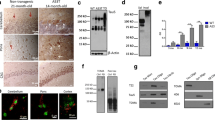Abstract
α-Synuclein is a presynaptic protein typically involved in synaptic regulation. However, it may form toxic aggregates and propagate in the CNS via cell-to-cell transmission, which have been identified as a key part in the pathophysiology of Parkinson’s disease (PD). Multiple strategies are being investigated to mitigate this; these include passive and active immunization against α-synuclein, among other immunotherapies and/or other α-synuclein-targeting compounds. Ultimately, these techniques aim to lessen neurotoxicity by increasing α-synuclein clearance and reducing the accumulation of toxic α-synuclein aggregates, potentially slowing the progression of PD through disease-modifying effects.
Similar content being viewed by others
References
Vijayakumar D, Jankovic J. Slowing Parkinson’s disease progression with vaccination and other immunotherapies. CNS Drugs. 2022;36(4):327–43.
Hadi F, Akrami H, Totonchi M, et al. α-Synuclein abnormalities trigger focal tau pathology, spreading to various brain areas in Parkinson’s disease. J Neurochem. 2020;157:727–51.
Schwab AD, Thurston MJ, Machhi J, et al. Immunotherapy for Parkinson’s disease. Neurobiol Dis. 2020;137:104760.
Wang Z, Gao G, Duan C, et al. Progress of immunotherapy of anti-α-synuclein in Parkinson’s disease. Biomed Pharmacother. 2019;115: 108843.
Olanow CW, Brundin P. Parkinson’s disease and alpha synuclein: is Parkinson’s disease a prion-like disorder? Mov Disord. 2013;28(1):31–40.
Duffy MF, Collier TJ, Patterson JR. Lewy body-like alpha-synuclein inclusions trigger reactive microgliosis prior to nigral degeneration. J Neuroinflammation. 2018;15:1–18.
Tan EK, Chao YX, West A, et al. Parkinson disease and the immune system: associations, mechanisms and therapeutics. Nat Rev Neurol. 2020;16:303–18.
Wong YC, Holzbaur EL. Autophagosome dynamics in neurodegeneration at a glance. J Cell Sci. 2015;128(7):1259–67.
Games D, Valera E, Spencer B, et al. Reducing C-terminal-truncated alpha-synuclein by immunotherapy attenuates neurodegeneration and propagation in Parkinson’s disease-like models. J Neurosci. 2014;34(28):9441–54.
Alam P, Bousset L, Melki R, et al. α-Synuclein oligomers and fibrils: a spectrum of species, a spectrum of toxicities. J Neurochem. 2019;150:522–34.
Melki R. Role of different alpha-synuclein strains in synucleinopathies, similarities with other neurodegenerative diseases. J Parkinsons Dis. 2015;5:217–27.
Pearce MM. Prion-like transmission of pathogenic protein aggregates in genetic models of neurodegenerative disease. Curr Opin Genet Dev. 2017;44:149–55.
Wong YC, Krainc D. α-synuclein toxicity in neurodegeneration: mechanism and therapeutic strategies. Nat Med. 2017;23:1–13.
Nedergaard M, Goldman SA. Glymphatic failure as a final common pathway to dementia. Science. 2020;370:50–6.
Lashuel HA, Overk CR, Oueslati A, et al. The many faces of alpha-synuclein: from structure and toxicity to therapeutic target. Nat Rev Neurosci. 2013;14(1):38–48.
Price DL, Koike MA, Khan A, et al. The small molecule alpha-synuclein misfolding inhibitor, NPT200-11, produces multiple benefits in an animal model of Parkinson’s disease. Sci Rep. 2018;8(1):16165.
Pagan F, Hebron M, Valadez EH. Nilotinib effects in Parkinson’s disease and dementia with lewy bodies. J Parkinsons Dis. 2016;6(3):503–17.
Simuni T, Fiske B, Merchant K. Efficacy of nilotinib in patients with moderately advanced Parkinson disease: a randomized clinical trial. JAMA Neurol. 2021;78(3):312–20.
Sahin C, Lorenzen N, Lemminger L, et al. Antibodies against the C-terminus of alpha-synuclein modulate its fibrillation. Biophys Chem. 2017;220:34–41.
Schofield DJ, Irving L, Calo L. Preclinical development of a high affinity α-synuclein antibody, MEDI1341, that can enter the brain, sequester extracellular α-synuclein and attenuate α-synuclein spreading in vivo. Neurobiol Dis. 2019;132: 104582.
Sweeney MD, Sagare AP, Zlokovic BV. Blood-brain barrier breakdown in Alzheimer disease and other neurodegenerative disorders. Nat Rev Neurol. 2018;14(3):133–50.
Folke J, Ferreira N, Brudek T, et al. Passive immunization in alpha-synuclein preclinical animal models. Biomolecules. 2022;12(2):168.
Jankovic J, Goodman I, Safirstein B. Safety and tolerability of multiple ascending doses of PRX002/RG7935, an anti-synuclein monoclonal antibody, in patients with Parkinson disease: a randomized clinical trial. JAMA Neurol. 2018;75(10):1206–14.
Pagano G, Boess FG, Taylor KI. A phase II study to evaluate the safety and efficacy of prasinezumab in early Parkinson’s disease (PASADENA): rationale, design, and baseline data. Front Neurol. 2021;12:705407.
Brys M, Fanning L, Hung S. Randomized phase I clinical trial of anti–α-synuclein antibody BIIB054. Mov Disord. 2019;34(8):1154–63.
Fjord-Larsen L, Thougaard A, Wegener KM, et al. Nonclinical safety evaluation, pharmacokinetics, and target engagement of Lu AF82422, a monoclonal IgG1 antibody against alpha-synuclein in development for treatment of synucleinopathies. MAbs. 2021;13(1):1994690.
Volc D, Poewe W, Kutzelnigg A. Safety and immunogenicity of the α-synuclein active immunotherapeutic PD01A in patients with Parkinson’s disease: a randomised, single-blinded, phase 1 trial. Lancet Neurol. 2020;19(7):591–600.
Poewe W, Di V, Seppi K. Safety and tolerability of active immunotherapy targeting α-synuclein with PD03A in patients with early Parkinson’s disease: a randomized, placebo-controlled, phase 1 study. J Parkinsons Dis. 2021;11(3):1079–89.
Nimmo JT, Verma A, Dodart JC, et al. Novel antibodies detect additional α-synuclein pathology in synucleinopathies: potential development for immunotherapy. Alzheimer’s Res Ther. 2020;12(1):159.
Magistrelli L, Comi C. Beta2-adrenoceptor agonists in Parkinson’s disease and other synucleinopathies. J Neuroimmune Pharmacol. 2020;15(1):74–81.
Wang W, Nguyen LTT, Burlak C. Caspase-1 causes truncation and aggregation of the Parkinson’s disease-associated protein α-synuclein. Proc Natl Acad Sci USA. 2016;113(34):9587–92.
Van der Perren A, Macchi F, Toelen J, et al. FK506 reduces neuroinflammation and dopaminergic neurodegeneration in an alpha-synuclein-based rat model for Parkinson’s disease. Neurobiol Aging. 2015;36(3):1559–68.
Yun SP, Kam TI, Panicker N, et al. Block of A1 astrocyte conversion by microglia is neuroprotective in models of Parkinson’s disease. Nat Med. 2018;24(7):931–8.
Author information
Authors and Affiliations
Corresponding author
Ethics declarations
Funding
The preparation of this review was not supported by any external funding.
Authorship and conflict of interest
J. Paik is a salaried employee of Adis International Ltd/Springer Nature and declares no relevant conflicts of interest. All authors contributed to the review and are responsible for the article content.
Ethics approval, Consent to participate, Consent for publication, Availability of data and material, Code availability
Not applicable.
Rights and permissions
Springer Nature or its licensor (e.g. a society or other partner) holds exclusive rights to this article under a publishing agreement with the author(s) or other rightsholder(s); author self-archiving of the accepted manuscript version of this article is solely governed by the terms of such publishing agreement and applicable law.
About this article
Cite this article
Paik, J. Targeting toxic forms of α-synuclein with immunotherapy could alter the progression of Parkinson’s disease. Drugs Ther Perspect 38, 467–471 (2022). https://doi.org/10.1007/s40267-022-00950-6
Accepted:
Published:
Issue Date:
DOI: https://doi.org/10.1007/s40267-022-00950-6



